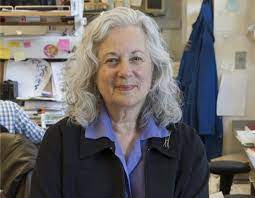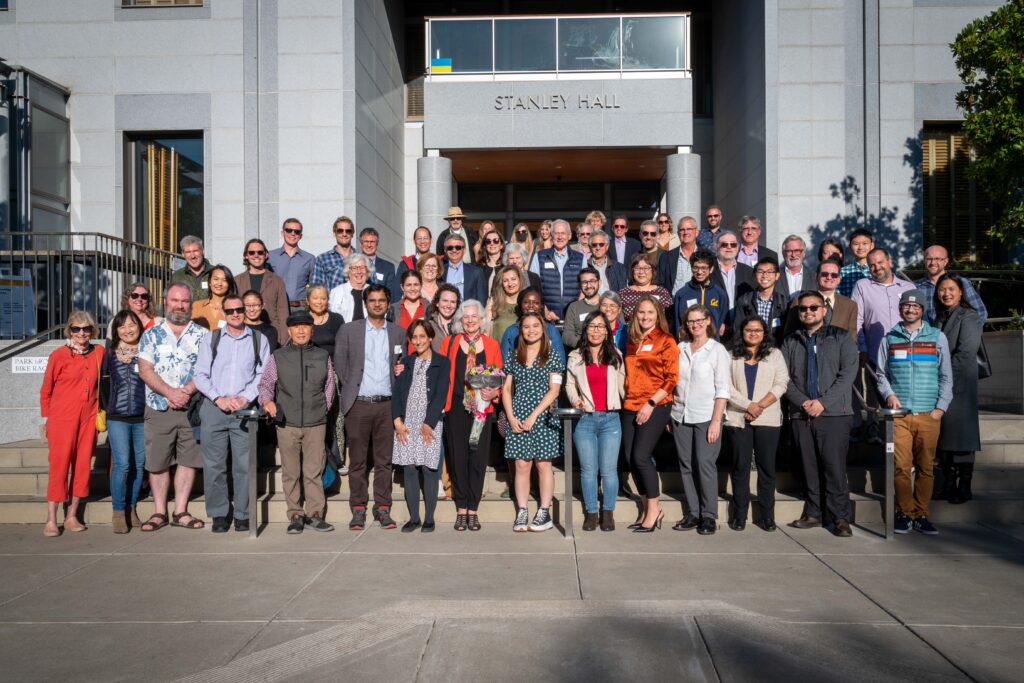Judith Klinman has been a faculty member at UC Berkeley since 1978 where she is currently a Professor of the Graduate School. She has twice been appointed Chancellor’s Professor at UCB and is an elected member of the National Academy of Sciences, the American Academy of the Arts and Sciences, the American Association of the Advancement of Science, and the American Philosophical Society. Among other awards, she was presented with the National Medal of Science by President Barack Obama in 2014. Her lab’s research is concerned with the nature of enzyme catalysis.
QB3-Berkeley: Over your decades of experience as a scientist, what are some of the findings or impacts about which you’re most proud?
Judith Klinman: We discovered a new class of cofactors. That discovery was a wild ride and went in the face of previous proposals. These cofactors are called quinone cofactors and they’re found attached to proteins, and they come from the naturally occurring amino acids. There are four members of this class and two were discovered in our lab and solved a fundamental unanswered question over many years—how do these enzymes work? One of the enzymes is involved in collagen crosslinking, for example. Some are prokaryotic, some are ubiquitous. But we discovered their cofactor structures, which in itself was exciting. We figured out how they’re made. And then we figured out how they work. This discovery was a whole phase of research in the laboratory.
We’ve also worked on O2-based enzyme systems and tried to derive some rules for how dioxygen activation takes place in biology. How do we use the oxygen? How does oxygen get reduced so it can be utilized without causing oxidative damage? How does this occur in different metal-containing enzymes? In the area of C-H activation, we found compelling evidence for quantum mechanical tunneling, meaning that hydrogen can react as a wave. And if it behaves as a wave, it doesn’t have to go over the top of the reaction barrier; it will go through the barrier. That was really a fundamental discovery that played a role in creating the new field called quantum biology.
Recently, we’ve begun to look at avian migrate migration, which is dependent on an aspect of quantum biology. This (QB) is a burgeoning field, and there was a new Gordon Research Conference last year in Texas, and I gave the keynote lecture. The whole field of quantum biology is both puzzling and controversial. And it’s really exciting.
We also were finally able (after many years of trying) to resolve the pathway for the production of a unique redox cofactor in bacteria, that depends on six gene products to transform a small peptide into the freestanding cofactor, pyrroloquinoline quinone (PQQ). Although humans do not synthesize PQQ themselves, this molecule is considered a potent antioxidant.
As you can see, I’m very excited by my lab’s research. I’m proud of the people in the lab. I’ve had such terrific co-workers and continue to do so. I’m really proud of what they’ve accomplished, and they’ve gone on to do well for themselves, too.
QB3: Could you tell us about the group of scientists that you were a part of, as described in the book Every Other Thursday?
JK: I joined in 1980—almost 44 years ago. The group was founded 46 years ago and has seven members currently. We have met twice a month for 46 years in person with the exception of COVID, during which we met on Zoom. The founding member died in July of 2022. She was a very dear friend of mine, and her loss has been a real shock for me and for the whole group. But we’ve helped each other. The women are now primarily in their 70s and 80s; the oldest woman is 94. We’ve gone through the initial phases of getting tenure, creating successful labs, and have now moved into the era of new questions like: How do we grow old? How do we manage ourselves? And do we still want to work? What do we do with ourselves once we stop working? Without planning to, we started a model of how women could form small groups and meet regularly and support their personal and professional advancement. It’s been very successful.

I’ve seen other groups like ours forming, too. Last year, I received a copy of an article written in a Stanford magazine about a group of six women who have created a model that’s like ours. The article didn’t mention our group—an example of convergent evolution? But that they started this group of six women, and they all got tenure and have begun to raise families. It is hard to be a scientist and a working parent; you run into bumps in the road. Our group has been quite a lesson for me, for all of us. None of us is a psychologist, and we don’t have a leader. We do our best and we love each other dearly. And we really have made a difference in each other’s lives.
QB3: You were the first female chair of the Department of Chemistry at UC Berkeley, and you’re considered by many to be a pioneer for women scientists. Are there barriers that have gotten better for scientists from traditionally underrepresented groups?
JK: That’s a long, long road. When I first came to Berkeley, I was the only woman in the department. I was very alone in the Department of Chemistry as a woman, but slowly that’s changing. Today women are perceived as contenders. And the Nobel Prizes for Francis Arnold, Jennifer Doudna, and Carolyn Bertozzi, has stepped that up; women are getting recognized, and more and more prizes are being awarded to women.
I initiated an award at the American Society of Biochemistry and Molecular Biology in honor of Mildred Cohn at the University of Pennsylvania. Mildred was a pioneer who preceded me by a generation and someone I got to know fairly well. When the award was established, there was an argument that we shouldn’t restrict it to women—that Mildred would never have wanted to win an award that was restricted just to women. And I had already refused to be nominated for the Garvan-John M. Olin Medal from the American Chemical Society because I didn’t want to be given an award that was restricted to women. But here’s where everything turns and we flip it 180 degrees, because now women are doing so magnificently in science that I think it’s fabulous that the Mildred Cohn award has been awarded only to women—and its first awardee was Jennifer Doudna. Over time, representation has been changing the face of science and women now have the access to facilities, money, and staffing. Women are inherently as brilliant as men and they’re now able to pursue careers and creative trajectories that are unique to them. I’m speaking with regard to women because that’s what I know about. But it’s also true for other underrepresented minorities. Thank goodness that landscape is changing as well.
QB3: What are your favorite things to do when you’re not working?
JK: I work too much! What do I do when I’m not working? I like to garden. I hate commercial tomatoes. Heirloom tomatoes are a big portion of my summer growing.
When I’m not in the garden, I’m dabbling in art. I’ve just started up again, in acrylics, and I’m enjoying learning about color. When I’m painting, I find that I can quiet myself down and enjoy it. I like to read and hike as much as I can and see friends. Travel is kind of off the books now because I’m trying to cut back on air travel. And because of rapid climate deterioration, I have a mission to limit the amount of air travel that scientists do for conferences and work. I do travel once or twice a year, but I try to cut back, while most people at my age choose to travel a lot.
QB3: What advice would you give to students who are interested in becoming scientists?
JK: Pick something that you’re passionate about and that you’re good at. That interface of natural talent and passion is a killer combination if you can identify it. If you’re passionate about something, but it’s difficult for you and you struggle in the field, that’s not fun. And if you pick something you’re really good at, but it doesn’t excite you, that’s not fun either.
My other piece of advice: be a squeaky wheel for yourself. Women are often silent and taught to behave themselves, but I think that every young budding female scientist must be their own squeaky wheel.
